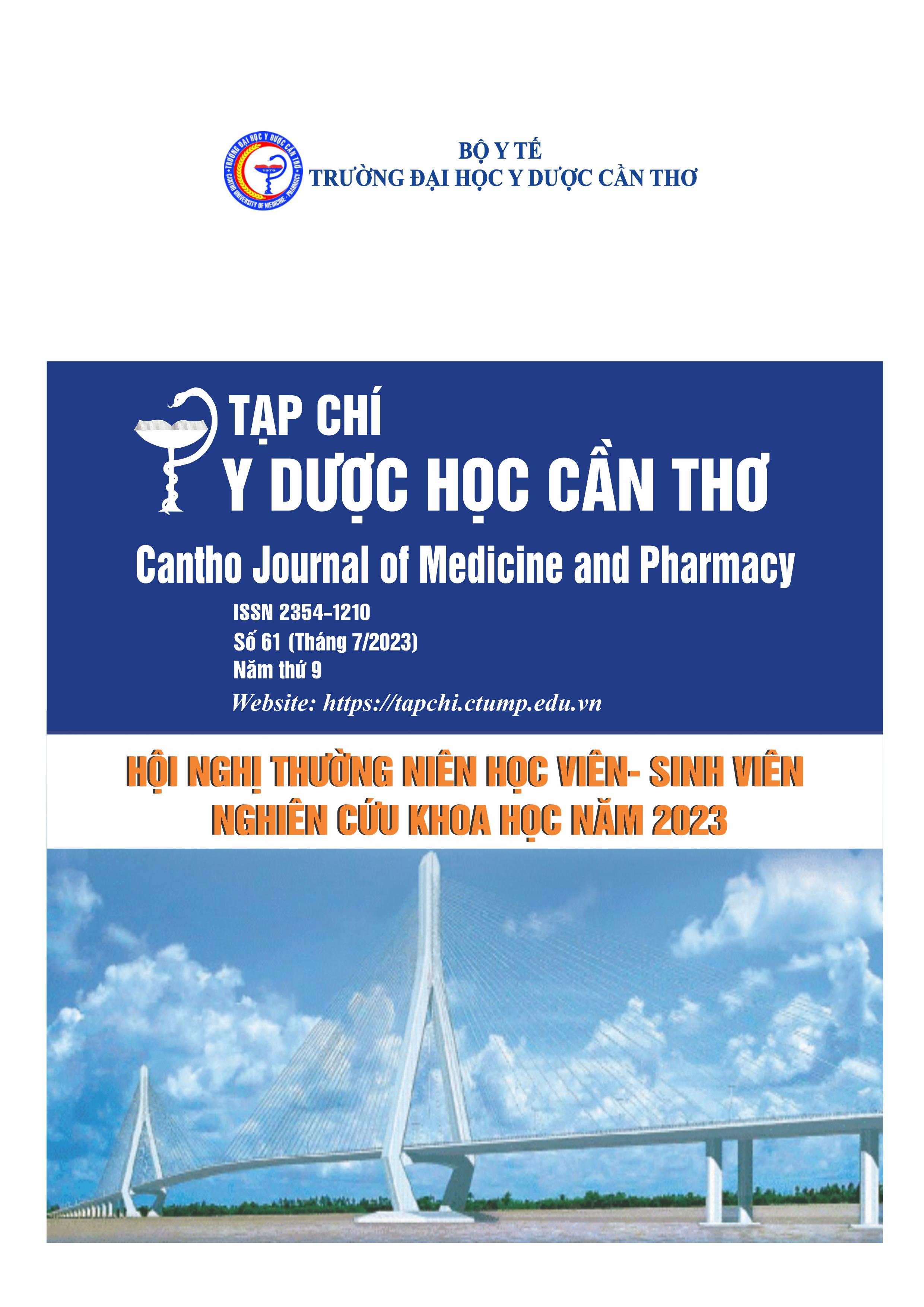STUDY ON RATE OF CHLAMYDIA TRACHOMATIS INFECTION AND RELATED FACTORS AMONG PREGNANT WOMAN IN THE FIRST TRIMESTER AT CAN THO OBSTETRICS AND GYNECOLOGY HOSPITAL IN 2021-2023
Main Article Content
Abstract
Background: Sexually transmitted diseases are one of the most common transmission diseases worldwide, in which Chlamydia is the disease with the leading infection rate. In pregnant woman, Chlamydia infection can lead to adverse pregnancy and newborn outcomes. Objectives: To determine the rate of Chlamydia trachomatis infection and find out some associated factors with Chlamydia trachomatis infection among pregnant woman in the first trimester. Materials and methods: A cross-sectional study and analysis, survey of 350 pregnant woman in the first trimester, from 7/2021 to 6/2023 at Can Tho Obstetrics and Gynecology Hospital. Results: The rate of Chlamydia trachomatis infection among pregnant woman in the first trimester was 4% (14/350 cases). 57.1% pregnant woman infected Chlamydia trachomatis were asymptomatic. Pregnant woman having more than one sex partners in their lifetime were increase the risk of Chlamydia trachomatis infection by 5.84 (OR = 5.836, 95% CI: 1.472-23.143) with p = 0.029. Pregnant woman having history of low reproductive tract infections also were increase the risk of Chlamydia trachomatis infection by 3.38 (OR = 3.381, 95% CI: 1.132-10.099) with p = 0.033. Conclusions: The rate of Chlamydia trachomatis infection among pregnant woman in the first trimester was 4%. Most of pregnant woman infected Chlamydia trachomatis were asymptomatic. Woman having more than one sex partners in their lifetime and having history of low reproductive tract infections were associated with Chlamydia trachomatis infection in the first trimester of pregnancy.
Article Details
Keywords
Chlamydia trachomatis, Chlamydia infection, first trimester
References
2. World Health Organization. WHO guidelines for the treatment of Chlamydia trachomatis. 2016.
3. Wynn A., Bristow C. C., Cristillo A. D., Murphy S. M., va den Broek N., et al. Sexually Transmitted Infections in Pregnancy and Reproductive Health: Proceedings of the STAR Sexually Transmitted Infection Clinical Trial Group Programmatic Meeting. Sex Transm Diseases. 2020. 47(1), 5-11, doi: 10.1097/OLQ.0000000000001075.
4. Davey D. L Joseph, Shull H. I., Billings J. D., Wang D., Adachi K., et al. Prevalence of Curable Sexually Transmitted Infections in Pregnant Women in Low- and Middle-Income Countries From 2010 to 2015: A Systematic Review. Sex Transm Diseases. 2016. 43(7), 450-458, doi: 10.1097/OLQ.0000000000000460.
5. Nguyen Minh, Le Giang M, Nguyen Hanh T. T, Nguyen Hinh Duc and Klausner J. D. Acceptability and feasibility of sexually transmissible infection screening among pregnant women in Hanoi, Vietnam. Sexual Health. 2019. 16(2), 133-138, https://doi.org/10.1071/SH18041.
6. Ong J. J., Chen M., Hocking J., Fairley C. K., Carter R., et al. Chlamydia screening for pregnant women aged 16-25 years attending an antenatal service: a cost-effectiveness study. BJOG: An International Journal of Obstetrics & Gynecology. 2016. 123(7), 1194-1202, https://doi.org/10.1111/1471-0528.13567.
7. Op de Coul E. L. M., Peek D., van Weert Y. W., Morré S. A., Rours I., et al. Chlamydia trachomatis, Neisseria gonorrhoea, and Trichomonas vaginalis infections among pregnant women and male partners in Dutch midwifery practices: prevalence, risk factors, and perinatal outcomes. Reproductive Health. 2021. 18(1), 132, https://doi.org/10.1186/s12978-021-01179-8.
8. Cabeza J., García P. J., Segura E., García P., Escudero F., et al. Feasibility of Chlamydia trachomatis screening and treatment in pregnant women in Lima, Peru: a prospective study in two large urban hospitals. Sex Transm Infect. 2015. 91(1), 7-10, doi: 10.1136/sextrans-2014-051531.
9. Li C., Tang W., Ho H. C., Ong J. J., Zheng X., et al. Prevalence of Chlamydia trachomatis Among Pregnant Women, Gynecology Clinic Attendees, and Subfertile Women in Guangdong, China: A Cross-sectional Survey. Open Forum Infect Dis. 2021. 8(6), ofab206, https://doi.org/10.1093/ofid/ofab206.
10. Cunningham F. Gary, Leveno K. J., Bloom S. L., Dashe J. S., Hoffman B. L., et al. Williams obstetrics. McGraw-Hill Education. 2018. 1945-1946.
11. Vallely L. M., Toliman P., Ryan C., Rai G., Wapling J., et al. Prevalence and risk factors of Chlamydia trachomatis, Neisseria gonorrhoeae, Trichomonas vaginalis and other sexually transmissible infections among women attending antenatal clinics in three provinces in Papua New Guinea: a cross-sectional survey. Sex Health. 2016. 13(5), 420-427, https://doi.org/10.1071/SH15227.
12. Goggins E. R., Chamberlain A. T., Kim T. G., Young M. R., Jamieson D. J., et al. Patterns of Screening, Infection, and Treatment of Chlamydia trachomatis and Neisseria gonorrhea in Pregnancy. Obstetrics & Gynecology. 2020. 135(4), 799-807, doi: 10.1097/AOG.0000000000003757.
13. Silveira M. F. D., Sclowitz I. K. T., Entiauspe L. G., Mesenburg M. A., Stauffert D., et al. Chlamydia trachomatis infection in young pregnant women in Southern Brazil: a cross-sectional study. Cad Saude Publica. 2017. 33(1), e00067415, https://doi.org/10.1590/0102-311X00067415.
14. Beckmann C. R. B., Ling F. W., Herbert W. N. P., Laube D. W., Smith R. P., et al. Obstetrics and gynecology. Lippincott Williams & Wilkins. 2013. 294-297.


